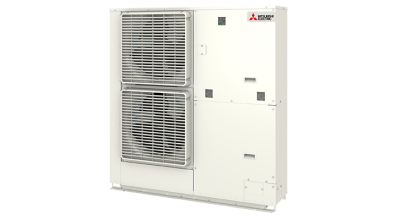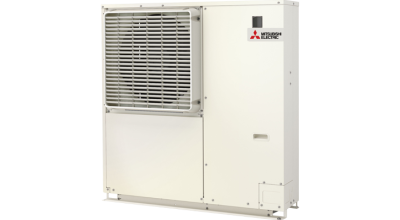
ECOV Series Refrigeration Condensing Units
The ECOV Series Refrigeration Condensing Units utilise non-flammable CO2 refrigerant (R744), with a GWP of only 1 - meaning that CO2 emissions are significantly reduced when compared to systems using HFC refrigerants.
View Product
ECOV-X15VA Refrigeration Condensing Unit
The ECOV Series Refrigeration Condensing units use natural CO2 refrigerant (R744) and inverter technology to deliver reliable, energy efficient cooling and freezing.
View ProductFrequently Asked Questions
What is a refrigeration condensing unit?
A refrigeration condensing unit reduces the temperature of a space to chill or freeze products, usually for preservation. This is done by using a refrigerant to remove heat from the indoor space and relocating it to an outdoor space via a fan in the condensing unit. This process is vital for keeping equipment like commercial refrigeration cabinets and cold-room working efficiently
What refrigerants do our condensing units use?
Mitsubishi Electric’s range of condensing units use R744 commonly referred to as CO2 which is a natural refrigerant. It has one of the lowest of any refrigerant with a Global Warming Potential (GWP) of 1. This is a significantly lower GWP when compared to traditional refrigerants such as R448A which has a GWP of 1390, which makes the ECOV units the perfect choice for end users looking to significantly reduce the carbon emissions of their estates. Additionally, R744 is non-flammable and non-toxic making it ideally suited for commercial applications
What can a condensing unit be used for?
Mitsubishi Electric’s condensing unit range offers various sizes which makes it ideally suited for a wide range of applications. Our units offer the option of chilling or freezing applications and heat recovery across the range. The applications include small retail shops, petrol filling stations, larger cold storage rooms including wholesalers, light industrial warehouses, distribution centres. Applications also include smaller cold-rooms such as restaurants, pubs, café’s, hotels, pharmacies, hospitals and many more.
What is the difference between a refrigeration condensing unit and an air conditioner?
Refrigeration condensing units and air conditioners operate using the same principles of relocating heat, however they differ in the temperatures they can achieve. An air conditioner is designed for comfort cooling targeting temperatures of 21C to 25C depending on preference, refrigeration condensing units are designed to store temperature sensitive products at much lower temperatures. Mitsubishi Electric’s ECOV units can operate anywhere between +10C to -35C making it ideally suited to almost all use cases.
What carbon savings can be achieved using CO2 as a refrigerant?
The example below is based on Mitsubishi Electric’s TM65 calculations and represents the embodied carbon of the ECOV product range using different refrigerants. It provides an indication of the savings that can be realised by using CO2, which is used as standard in the ECOV unit, versus other refrigerants
|
|
Embodied Carbon Result with 'Mid-level TM65 Calculation' Method (kg CO2e) - Total With R744 |
Embodied Carbon Result with 'Mid-level TM65 Calculation' Method (kg CO2e) - Total With R448A |
Embodied Carbon Result with 'Mid-level TM65 Calculation' Method (kg CO2e) - Total With R404A |
|
ECOV-X15VA |
1194 |
4739 |
11222 |
|
ECOV-X37/55VA |
2690 |
18157 |
46448 |
